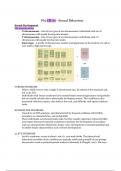Class notes
PSYB64 Chapter 10 - Sexual Behaviour notes
- Course
- PSYB64 (PSYB64)
- Institution
- University Of Toronto (U Of T )
Detailed textbook notes for Chapter 10 Sexual Behaviour. Freberg, L. (2018). Discovering Behavioral Neuroscience: An introduction to Biological Psychology. Cengage Learning.
[Show more]



